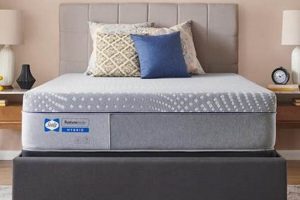This type of sleep surface offers a unique combination of comfort and support, aiming to provide the pressure relief associated with softer materials alongside the underlying stability necessary for spinal alignment. It generally incorporates both conforming layers on top and a robust core construction. This design intends to cater to individuals who seek a balanced feel, avoiding the extremes of either a very soft or a very hard bed.
The importance of a well-constructed sleep surface lies in its potential to promote better sleep quality and reduce discomfort. The configuration described seeks to accomplish this by distributing weight evenly and minimizing pressure points while maintaining proper support. Historically, mattress designs have evolved to address varying sleep preferences and address the need for both comfortable and health-conscious sleep solutions.
The ensuing discussion will delve into specific characteristics and materials used in the construction of such sleep systems, exploring how these factors contribute to the overall feel and performance. Furthermore, different sleeper profiles and their suitability for this type of mattress will be examined.
Tips for Selecting a Balanced Sleep Surface
Choosing a sleep surface that offers both comfort and support requires careful consideration. The following tips provide guidance for selecting a mattress that balances these essential features.
Tip 1: Research Layer Composition. Examine the types of materials used in the comfort layers and support core. High-density foams, latex, and micro-coils in the comfort layers can provide contouring and pressure relief. A strong coil system or dense foam core is essential for adequate support. For example, a mattress might feature a quilted top layer with gel-infused memory foam over a pocketed coil system.
Tip 2: Assess Edge Support. Evaluate the firmness and stability along the mattress edges. Strong edge support prevents roll-off and maximizes the usable sleep surface. Look for reinforced edges made with high-density foam or steel coils around the perimeter.
Tip 3: Consider Your Sleep Position. Different sleep positions require varying levels of support. Back sleepers generally benefit from a firmer surface for spinal alignment, while side sleepers often prefer a slightly softer surface for shoulder and hip comfort. Stomach sleepers need a supportive surface to prevent spinal arching.
Tip 4: Check Temperature Regulation. Certain materials can trap heat, leading to discomfort during sleep. Look for mattresses with breathable materials like open-cell foam, cotton, or wool. Gel infusions and phase-change materials can also help regulate temperature.
Tip 5: Evaluate Motion Isolation. If sharing a bed, motion isolation is crucial. Memory foam and pocketed coils excel at minimizing motion transfer between partners. A continuous coil system will generally transfer motion more readily.
Tip 6: Understand Warranty and Trial Period. Review the mattress warranty and trial period before purchasing. A longer trial period allows sufficient time to assess the mattress’s suitability. Note any specific conditions or exclusions in the warranty.
Tip 7: Read Reviews. Consider consumer reviews to get insight into performance and long-term durability. Pay attention to recurring themes and potential issues reported by other users.
Selecting a mattress involves a balance of personal preference and objective assessment of its features. A thoughtfully chosen sleep surface can contribute to improved sleep quality and overall well-being.
The subsequent sections of this article will further explore the factors influencing mattress performance and provide guidance for maintaining a comfortable and supportive sleep environment.
1. Balanced Support
Balanced support constitutes a primary design objective when crafting mattresses. The intention is to simultaneously offer conforming comfort and underlying structural integrity. This balance directly relates to the performance and perceived feel of a sleep surface, particularly in the context of a mattress intended to provide both plushness and firmness.
- Core Stability
Core stability refers to the foundational element of the mattress, often comprising innerspring coils or high-density foam. The role of this component is to prevent excessive sinking and maintain spinal alignment throughout the sleep cycle. For example, a coil system with individually encased springs minimizes motion transfer and provides targeted support to different areas of the body. Insufficient core stability results in inadequate support, potentially leading to discomfort and musculoskeletal strain.
- Conforming Layers
Conforming layers, typically composed of materials like memory foam or latex, adapt to the body’s contours to relieve pressure points. These layers are strategically positioned atop the support core to enhance comfort without compromising overall firmness. As an example, a thin layer of gel-infused memory foam can provide initial cushioning while maintaining a firm underlying feel. The absence of adequate conforming layers can result in a sleep surface that feels too rigid and unforgiving.
- Weight Distribution
Balanced support facilitates even distribution of body weight across the mattress surface. This minimizes localized pressure and promotes proper circulation. For instance, a mattress with zoned support provides varying levels of firmness to different areas, such as the lumbar region, to accommodate individual needs. Uneven weight distribution can lead to pressure points and disrupted sleep.
- Edge Support
Edge support ensures the perimeter of the mattress maintains its shape and prevents excessive sagging. This feature is particularly relevant for individuals who utilize the full surface area of the bed or who sit on the edge while dressing. Reinforced edges, often constructed with high-density foam or additional coils, enhance the stability and usable surface area. Weak edge support reduces the overall support and usable space.
The integration of these facets within a mattress aims to achieve the sought-after characteristic of balanced support. By carefully combining a stable core with conforming layers and attention to weight distribution and edge support, a sleep surface strives to cater to diverse sleep preferences while prioritizing proper spinal alignment and pressure relief.
2. Pressure Point Relief
Pressure point relief, in the context of sleep surfaces, refers to the reduction of concentrated stress exerted on specific areas of the body during sleep. These areas, often bony prominences such as shoulders, hips, and knees, are susceptible to discomfort when compressed against a firm, unyielding surface. T
he design of a plush firm mattress directly addresses this issue through the incorporation of materials that conform to the body’s contours, distributing weight more evenly and minimizing localized pressure. For instance, a construction featuring a layer of memory foam atop a firm innerspring system aims to provide both cushioning for pressure points and stable support for spinal alignment. Without adequate pressure point relief, individuals may experience tossing and turning, leading to disrupted sleep patterns and potential aggravation of existing musculoskeletal conditions.
The effectiveness of pressure point relief within a plush firm mattress is contingent upon several factors, including the type and density of materials used in the comfort layers. Higher-density memory foam, for example, generally offers greater contouring and pressure reduction compared to conventional polyurethane foam. Furthermore, the thickness and configuration of these layers play a crucial role in determining the overall level of comfort. Individuals with specific medical conditions, such as arthritis or fibromyalgia, may particularly benefit from the pressure-relieving properties of a well-designed mattress. Conversely, a mattress lacking sufficient pressure relief could exacerbate pain and discomfort in these individuals.
In summary, the connection between pressure point relief and a plush firm mattress lies in the deliberate engineering of the sleep surface to mitigate concentrated stress on sensitive areas of the body. The selection of appropriate materials and construction techniques is paramount to achieving this goal. Understanding the role of pressure relief in promoting sleep quality is essential for both consumers and manufacturers in the mattress industry, as it directly impacts the comfort and well-being of individuals during sleep.
3. Spinal Alignment
Maintaining proper spinal alignment during sleep is paramount for minimizing back pain, preventing musculoskeletal issues, and fostering restorative rest. The design of a plush firm mattress directly addresses this need by aiming to provide a balance of support and conformity, ensuring the spine remains in a neutral position throughout the night. Misalignment can exacerbate existing conditions and create new sources of discomfort.
- Lumbar Support
The lumbar region, or lower back, requires adequate support to prevent excessive curvature and strain. A plush firm mattress should offer sufficient resistance in this area to maintain the natural arch of the spine. For example, some mattresses incorporate zoned support systems with firmer coils or foam in the lumbar region. Lack of adequate lumbar support can lead to lower back pain and stiffness.
- Shoulder and Hip Accommodation
Side sleepers require a mattress that allows the shoulders and hips to sink in slightly, preventing excessive pressure and spinal bending. A plush firm mattress achieves this through conforming comfort layers. For instance, a memory foam layer can contour to the body’s shape, distributing weight evenly. Insufficient accommodation can result in shoulder and hip pain.
- Cervical Alignment
The cervical spine, or neck, must be properly aligned with the rest of the spine to prevent neck pain and headaches. The mattress works in conjunction with the pillow to achieve this. A mattress that is too soft can cause the head to sink too low, while a mattress that is too firm may not provide adequate support. For example, a medium-firm mattress can provide the necessary balance of support and conformity. Poor cervical alignment can lead to neck pain, headaches, and even nerve compression.
- Even Weight Distribution
Consistent support across the entire sleep surface is crucial for maintaining spinal alignment. A plush firm mattress should prevent excessive sinking in any one area. For example, a mattress with a strong core and evenly distributed coils can provide consistent support. Uneven weight distribution can lead to spinal twisting and misalignment.
The interplay of these facets lumbar support, shoulder and hip accommodation, cervical alignment, and even weight distribution is critical for ensuring proper spinal alignment on a plush firm mattress. The design aims to promote a neutral spinal position, reducing the risk of pain and discomfort and facilitating more restorative sleep. When selecting a mattress, consideration of these factors is essential for individuals seeking to optimize their spinal health.
4. Material Composition
The construction of a sleep surface designed to offer both a plush feel and firm support hinges significantly on its material composition. The materials chosen directly dictate the level of comfort, support, durability, and temperature regulation offered. For instance, a plush firm mattress commonly employs a combination of high-density support foam or innerspring coils for core stability, overlaid with layers of memory foam, latex, or gel-infused foam for surface comfort and pressure relief. The arrangement and quality of these materials directly influence the overall sleep experience. Inferior materials can result in premature sagging, reduced support, and compromised comfort, negating the intended benefits of the design.
The selection of specific materials further impacts various aspects of mattress performance. For example, open-cell memory foam and natural latex offer enhanced breathability compared to conventional polyurethane foam, contributing to better temperature regulation and reduced heat retention during sleep. Similarly, the gauge and coil count of innerspring systems influence the level of support and motion isolation provided. The presence of certified materials, such as CertiPUR-US certified foam, ensures the absence of harmful chemicals and volatile organic compounds (VOCs), promoting a healthier sleep environment. Thus, a plush firm mattress featuring high-quality, strategically chosen materials is more likely to deliver the desired combination of comfort, support, and longevity.
In conclusion, material composition serves as a crucial determinant of the characteristics and performance of a plush firm mattress. Understanding the properties and potential benefits of various materials empowers consumers to make informed decisions, selecting a sleep surface that meets their individual needs and preferences. Challenges lie in accurately assessing material quality and durability prior to purchase, highlighting the importance of reputable brands and comprehensive product warranties. The strategic application of materials is essential to achieving a comfortable, supportive, and durable sleep environment.
5. Durability Factors
The longevity and consistent performance of a sleep surface are critical considerations for consumers. Various factors contribute to the overall lifespan and structural integrity of a mattress, directly influencing its long-term value and satisfaction. Understanding these elements allows for informed purchasing decisions.
- Core Construction Quality
The core of a mattress, whether composed of innerspring coils or high-density foam, provides the primary suppor
t structure. The quality of materials and construction techniques employed significantly impact the mattress’s ability to maintain its shape and support over time. For instance, a coil system constructed with tempered steel and reinforced edge support is more resistant to sagging and deformation. Conversely, a foam core utilizing low-density materials may exhibit premature compression and reduced support. The stability of the core is fundamental to the overall durability. - Material Density and Resilience
The density of foam layers and the resilience of comfort materials play a vital role in resisting wear and tear. High-density memory foam or latex, for example, is less prone to body impressions and retains its shape more effectively than lower-density alternatives. Resilience refers to the material’s ability to recover its original form after compression. A mattress employing resilient materials will maintain its comfort and support characteristics for a longer duration. This attribute prevents a decline in sleep quality over time.
- Cover Fabric and Stitching
The mattress cover not only contributes to surface comfort but also provides a protective layer for the underlying materials. The quality of the fabric and the strength of the stitching are crucial for preventing tears, stains, and other forms of damage. A durable cover, such as one constructed from tightly woven fibers, safeguards the internal components from external factors that can accelerate degradation. Seam integrity ensures the mattress maintains its structural form.
- Weight Capacity and Usage Patterns
A mattress’s stated weight capacity should be considered in relation to the body weight of the user(s). Exceeding the recommended weight limit can accelerate wear and tear, leading to premature sagging and reduced support. Furthermore, usage patterns, such as frequent sitting on the edge of the bed, can compromise edge support and overall durability. Adhering to recommended weight limits and minimizing stress on specific areas contributes to a longer lifespan.
These factors, individually and collectively, influence the durability of a sleep surface. Careful consideration of core construction, material density, cover quality, and usage patterns allows for the selection of a product that provides lasting comfort and support. Investing in a mattress with robust construction and high-quality materials can yield long-term benefits in terms of sleep quality and overall value.
Frequently Asked Questions About Plush Firm Mattresses
The following questions address common inquiries and misconceptions regarding sleep surfaces that combine a plush feel with firm support. The aim is to provide clarity and informed decision-making.
Question 1: Is a plush firm mattress suitable for all sleep positions?
While offering a balance of comfort and support, its suitability varies. Back sleepers typically benefit from the firmness, while side sleepers may find sufficient contouring for pressure relief. Stomach sleepers, however, may require a firmer surface to prevent spinal arching.
Question 2: What is the typical lifespan of a mattress with a plush firm design?
Longevity depends on material quality and usage. Generally, a well-constructed mattress can last between seven to ten years. However, factors such as weight, sleep habits, and maintenance practices influence its lifespan.
Question 3: Does a mattress of this type retain more heat than other designs?
Heat retention varies depending on the materials used in the comfort layers. Memory foam, for example, can retain more heat than latex or innerspring coils. However, gel infusions and open-cell foam structures can mitigate this issue.
Question 4: How does the firmness level of a plush firm mattress compare to other options?
It typically falls in the medium-firm range on a firmness scale. This level offers a balance between the conforming comfort of a softer mattress and the solid support of a firmer one.
Question 5: Are there specific maintenance requirements for mattresses of this design?
Regular rotation and the use of a mattress protector are recommended to extend the lifespan. Spot cleaning spills promptly can also prevent stains and damage.
Question 6: Can a plush firm mattress alleviate back pain?
While it may provide relief for some individuals, its effectiveness varies depending on the cause of the pain. It can promote proper spinal alignment, but consulting a medical professional is advisable for chronic back pain.
In summary, it offers a balanced sleep surface suitable for many, but careful consideration of individual sleep preferences and needs is crucial. Proper maintenance ensures longevity and continued support.
The subsequent discussion will explore potential health considerations associated with mattress selection and usage.
Concluding Remarks on Plush Firm Mattresses
This exploration has underscored the key characteristics and considerations surrounding a sleep surface designed to balance comfort with support. Factors such as material composition, durability, and individual sleep preferences significantly influence the suitability of the plush firm mattress. Proper spinal alignment and pressure point relief remain paramount considerations in mattress selection, impacting sleep quality and overall well-being.
Given the significance of sleep in maintaining health, thoughtful assessment of individual needs and careful examination of product specifications are essential. Continued research and advancements in sleep technology hold the potential to further optimize the design of mattresses, enhancing both comfort and support for a diverse range of individuals.







